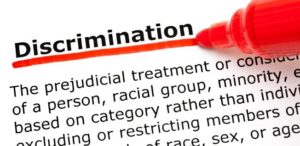Warning: Trying to access array offset on value of type bool in /home/daneciolino/public_html/lalegalethics/wp-content/plugins/footnotation/footnotation.php on line 193
Warning: Trying to access array offset on value of type bool in /home/daneciolino/public_html/lalegalethics/wp-content/plugins/footnotation/footnotation.php on line 193
 Effective December 1, 2019, New Mexico became the sixth state to adopt a disciplinary standard identical to or analogous to the anti-discrimination provision of ABA Model Rule 8.4. See N.M. Rule 16-804 (N.M. Oct. 15, 2019). To date, nine states have expressly declined to adopt the ABA’s model anti-discrimination rule. See ABA Center for Prof’l Responsibility, Policy Implementation Committee, Jurisdictional Adoption of Rule 8.4(g) of the ABA Model Rules of Professional Conduct (as of October 18, 2019).
Effective December 1, 2019, New Mexico became the sixth state to adopt a disciplinary standard identical to or analogous to the anti-discrimination provision of ABA Model Rule 8.4. See N.M. Rule 16-804 (N.M. Oct. 15, 2019). To date, nine states have expressly declined to adopt the ABA’s model anti-discrimination rule. See ABA Center for Prof’l Responsibility, Policy Implementation Committee, Jurisdictional Adoption of Rule 8.4(g) of the ABA Model Rules of Professional Conduct (as of October 18, 2019).
The New Rule in New Mexico
The new rule adopted in New Mexico provides that it is “professional misconduct” for a lawyer to:
engage in conduct that the lawyer knows or reasonably should know is harassment or discrimination on the basis of race, sex, religion, national origin, ethnicity, disability, age, sexual orientation, gender identity, or marital status in conduct related to the practice of law. This paragraph does not limit the ability of a lawyer to accept, decline, or withdraw from a representation in accordance with Rule 16-116 NMRA. This paragraph does not preclude legitimate advice or advocacy consistent with these rules.
Background: The 2016 Adoption of ABA Model Rule 8.4(g)
In 2016, the ABA amended Model Rule 8.4 to include a broad anti-discrimination and anti-harassment provision, and three revised comments. The amendment, which was sponsored by several ABA groups,1 added this new paragraph (g) to the black-letter of Rule 8.4:
It is professional misconduct for a lawyer to: . . . (g) engage in conduct that the lawyer knows or reasonably should know is harassment or discrimination on the basis of race, sex, religion, national origin, ethnicity, disability, age, sexual orientation, gender identity, marital status or socioeconomic status in conduct related to the practice of law. This paragraph does not limit the ability of a lawyer to accept, decline, or withdraw from a representation in accordance with Rule 1.16. This paragraph does not preclude legitimate advice or advocacy consistent with these rules.
See ABA Revised Resolution 109 (adopted Aug. 8, 2016).
It is often difficult to have a rational discussion about anti-discrimination and anti-harassment rule making. Some fervently believe that such provisions are yet another example of political correctness run a muck. Others just as fervently believe that such provisions serve to promote inclusiveness and confidence in the legal profession. Irrespective of viewpoint, every lawyer should be concerned about the breadth of the ABA’s model rule.
Irrespective of viewpoint, every lawyer should be concerned about the breadth of the ABA’s model rule.
First, the rule and its comments broadly define “harassment” to include any “derogatory or demeaning verbal conduct” by a lawyer relating to a person’s “race, sex, religion, national origin, ethnicity, disability, age, sexual orientation, gender identity, marital status or socioeconomic status.” Even words that are not “harmful” meet the definition of “harassment” if they are “derogatory or demeaning” and relate to a designated category of person.
Second, the rule subjects to discipline not only a lawyer who knowingly engages in harassment or discrimination, but also a lawyer who negligently utters a derogatory or demeaning comment. So, a lawyer who did not know that a comment was offensive will be disciplined if the lawyer should have known that it was. It will be interesting to see how the “objectively reasonable lawyer” will be constructed for purposes of making this determination.
Third, the rule and its comments subject to discipline not only a lawyer who slings a “derogatory or demeaning comment” directly at another person, but also a lawyer who makes an abstract comment about general types or categories of people. Indeed, in revising comment 4, the ABA expressly deleted language that would have limited the definition of “harassment” to include only derogatory or demeaning conduct directed “towards a person who is, or is perceived to be, a member of one of the groups.”
Fourth, the rule subjects to discipline a lawyer who discriminates on the basis of “socioeconomic status.” What is that? UCLA Law Professor Eugene Volokh raises this (valid) concern:
That term isn’t defined in the proposed rule, but the one definition I’ve seen — interpreting a similar ban on socioeconomic-status discrimination in the Sentencing Guidelines — is “an individual’s status in society as determined by objective criteria such as education, income, and employment.” United States v. Lopez, 938 F.2d 1293, 1297 (D.C. Cir. 1991); see also United States v. Peltier, 505 F.3d 389, 393 & n.14 (5th Cir. 2007) (likewise treating wealth as an element of socioeconomic status); United States v. Graham, 946 F.2d 19, 21 (4th Cir. 1991) (same).
Eugene Volokh, Banning Lawyers from Discriminating Based on ‘Socioeconomic Status’ in Choosing Partners, Employees or Experts, The Volokh Conspiracy (Aug. 10, 2016). Volokh questions whether this rule will prohibit a law firm from preferring lawyers, nonlawyer assistants, and expert witnesses with degrees from high-status educational institutions. Id.
Louisiana Considers Adopting an Anti-Discrimination Rule
On November 27, 2017, the LSBA Rules of Professional Conduct Committee reported that it would make “no recommendation” regarding the adoption of a rule prohibiting discrimination and harassment in conduct related to the practice of law. See Richard C. Stanley, Letter to LSBA Outreach and Diversity Director (Nov. 27, 2017). This “no recommendation” vote came after more than a year of analysis and discussion in the wake of the ABA’s adoption of Model Rule 8.4(g).
Prior to the committee’s vote, a subcommittee had proposed the addition of a new Louisiana Rule 8.4(h), that would have provided as follows:
It is professional misconduct for a lawyer to: . . . (h) engage in conduct in connection with the practice of law that the lawyer knows or reasonably should know involves discrimination prohibited by law because of race, color, religion, age, gender, sexual orientation, national origin, marital status, or disability. This Rule does not prohibit legitimate advocacy when race, color, religion, age, gender, sexual orientation, national origin, marital status, or disability are issues, nor does it limit the ability of a lawyer to accept, decline or withdraw from a representation in accordance with Rule 1.16.
See LSBA Rules of Professonal Conduct, Rule 8.4 Subcommittee Report Executive Summary at p. 2 (Mar. 24, 2017); see also LSBA Rules of Professional Conduct Committee, Rule 8.4 Subcommittee Report (Mar. 24, 2017) (full report). In July 2017, the LSBA Rules Committee published the subcommittee’s proposal and invited written comments on the adoption of a new anti-discrimination standard of professional conduct.
The invitation was well received; the committee received a large number of comments—including an opinion from the Louisiana Attorney General that the proposal was unconstitutional. The comments were overwhelmingly negative.
On October 30, 2017, the committee met in New Orleans to consider the comments received and to discuss adopting the ABA model rule or the subcommittee’s proposal. After a long debate, the committee voted 7-4 to make “no recommendation.” See Richard C. Stanley, Letter to LSBA Outreach and Diversity Director (Nov. 27, 2107). Although the committee’s chairperson noted that “it is difficult to summarize the rationale of the lengthy debate in its entirety, the primary arguments made by those opposing the rule” were as follows:
- Existing rules permit ODC to prosecute much of the conduct that would be covered by the proposed rule, “thus making it unnecessary.”
- The proposed rule contains ambiguous terms that could engender litigation and create uncertainty.
- The proposed rule may be unconstitutional.
Id. at pp. 1-2.
The committee’s decision was a good one. Louisiana clearly should not adopt the ABA’s standard. For all of the reasons discussed above, the ABA model rule is fraught with problems.
Moreover, the proposal of the subcommittee was also problematic . Granted, the subcommittee’s proposal was less problematic than the new ABA model rule. For example, it did not brand any sort of “harassment” as misconduct, and thereby avoided the myriad problems associated with the ABA anti-harassment standard. However, the subcommittee’s proposal still raised serious questions. It branded as “misconduct” purely negligent discrimination. And it inexplicably incorporated some of the ABA’s protected classes (race, religion, age, gender, sexual orientation, national origin, marital status, and disability), but excluded others (ethnicity, gender identity, and socioeconomic status).
Conclusion
In my view, Louisiana either should do nothing at all (like what the committee did), or adopt a simpler anti-discrimination standard that is directly tethered to anti-discrimination laws applicable to Louisiana lawyers. Such anti-discrimination laws would include those enacted by the federal government, the State of Louisiana, and local governments. Doing so would avoid the need for the LSBA to “keep up” with changing notions of what personal characteristics are worthy of class protection.2 Doing so would also avoid imposing discipline on innocent and merely negligent lawyers. Here is my proposed language:
It is professional misconduct for a lawyer to: . . . (h) engage in conduct in connection with the practice of law that the lawyer knows is unlawful discrimination prohibited by federal, state, or local law. This Rule does not prohibit legitimate advocacy when a protected personal characteristic is relevant to the representation, nor does it limit the ability of a lawyer to accept, decline or withdraw from a representation in accordance with Rule 1.16.
- The amendment was sponsored by the ABA’s Standing Committee on Ethics and Professional Responsibility, the Section of Civil Rights and Social Justice, the Commission on Disability Rights, the Diversity & Inclusion 360 Commission, the Commission on Racial and Ethnic Diversity in the Profession, the Commission on Sexual Orientation and Gender Identity, and the Commission on Women in the Profession. See Lorelei Laird, Discrimination and Harassment Will be Legal Ethics Violations Under ABA Model Rule, ABA Journal (Aug. 8, 2016, 6:36 p.m.). ↵
- For example, my proposal would brand as “misconduct” unlawful conduct based on personal characteristics protected by federal law such as race, color, religion, national origin, age, sex, sexual orientation, gender idenity, pregnancy, citizenship, familial status, disability status, veteran status, and genetic information. ↵
